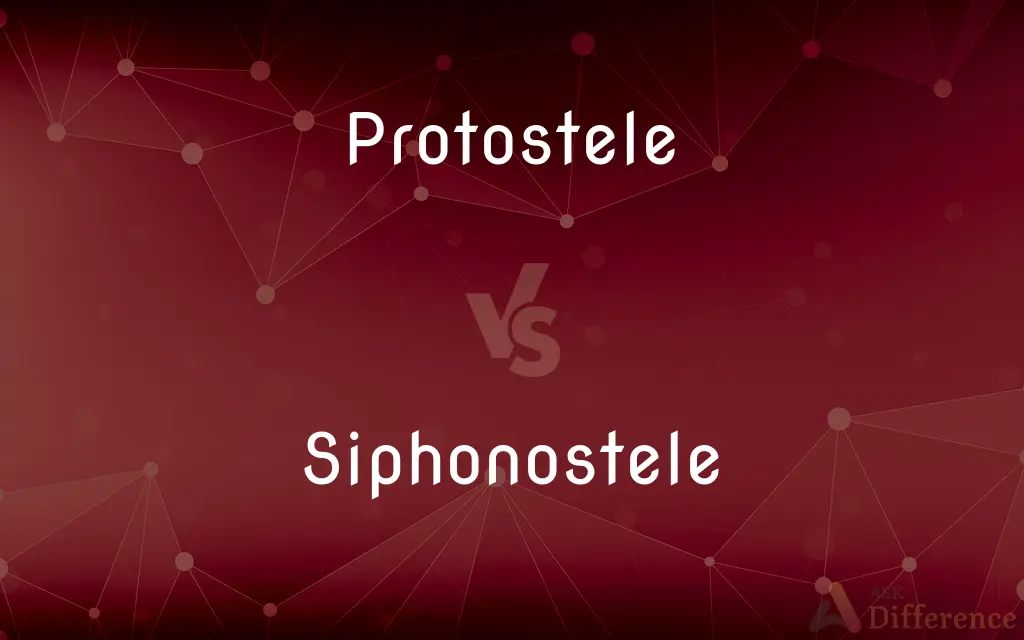Protostele vs. Siphonostele — What's the Difference?
Edited by Tayyaba Rehman — By Fiza Rafique — Updated on April 23, 2024
A protostele is the simplest form of stele in vascular plants, featuring a solid core of vascular tissue, while a siphonostele has a hollow cylinder of vascular tissue with pith in the center.

Difference Between Protostele and Siphonostele
Table of Contents
ADVERTISEMENT
Key Differences
Protostele, found in the earliest vascular plants, features a central core of vascular tissue that is undifferentiated. This arrangement is typical in roots and primitive plants. On the other hand, a siphonostele represents an evolutionarily advanced form, where the vascular tissue forms a cylinder around a central pith. This structure is common in the stems of ferns and some other vascular plants.
In a protostele, the phloem typically surrounds the xylem, forming a solid column that can support the plant and transport nutrients and water efficiently. Whereas in a siphonostele, the phloem is also positioned around the xylem, but there is a distinct separation caused by the presence of pith, which can store nutrients and provide additional structural support.
The structure of a protostele limits the size and complexity of the plant, as it does not allow for extensive growth or branching. This is in contrast to a siphonostele, which supports more complex and larger plant structures due to its more advanced vascular arrangement and the ability to support secondary growth.
Protosteles are characteristic of simpler plant forms, such as club mosses and some ferns, indicating an earlier stage in plant evolution. On the other hand, siphonosteles are found in more developed plants, including many ferns and seed plants, reflecting their more advanced evolutionary adaptations.
The evolution from protostele to siphonostele in plants marks significant progress in the ability to colonize diverse terrestrial environments. The more complex siphonostele allows for greater versatility and adaptability in environmental conditions compared to the more primitive protostele.
ADVERTISEMENT
Comparison Chart
Vascular Tissue Arrangement
Solid core, no pith
Cylindrical, with central pith
Evolutionary Stage
Primitive, early vascular plants
More advanced, later vascular plants
Plant Size and Complexity
Smaller, simpler plants
Larger, more complex plants
Function
Basic support and transport
Enhanced support, storage, and transport
Example Plants
Club mosses, early ferns
Modern ferns, seed plants
Compare with Definitions
Protostele
Characteristic of early primitive plants.
Protostele systems are typical in the fossil records of the earliest terrestrial plants.
Siphonostele
Supports secondary growth and complexity.
The structure of a siphonostele supports the secondary growth seen in many vascular plants.
Protostele
No internal differentiation or pith.
Unlike more developed systems, a protostele lacks internal complexity.
Siphonostele
A cylindrical arrangement of vascular tissue with a central pith.
The siphonostele design allows for more advanced vascular function in ferns.
Protostele
A central, solid cylinder of vascular tissue.
The protostele structure in ancient plants supported basic transport functions.
Siphonostele
Enables the plant to store nutrients in the pith.
The central pith in a siphonostele is crucial for nutrient storage.
Protostele
Supports fundamental plant survival needs.
The protostele efficiently manages the transport of water and nutrients despite its simplicity.
Siphonostele
Facilitates greater plant height and complexity.
The adaptation of the siphonostele allows plants to grow taller and branch more extensively.
Protostele
Primarily found in roots and simple stems.
Protosteles are observed in the roots of most seedless vascular plants.
Siphonostele
Found in more evolutionary advanced plants.
Siphonosteles are a hallmark of more recently evolved ferns and some gymnosperms.
Protostele
A stele that forms a solid core of xylem encased by phloem.
Siphonostele
A stele in which the vascular tissue is in the form of a cylinder surrounding the pith, as in the stems of most ferns and other seedless vascular plants.
Protostele
(botany) A type of stele, in which the vascular tissue in the stem forms a solid core, with no central pith or leaf gaps.
Siphonostele
(botany) A type of stele in which the vascular tissue in the stem forms a cylinder surrounding a central pith and possessing leaf gaps.
Common Curiosities
What evolutionary advantages does a siphonostele provide?
A siphonostele supports larger plant structures, more efficient nutrient transport, and storage, aiding in the survival and spread of plants in diverse environments.
How do protostele and siphonostele differ in function?
Protosteles primarily support basic transport and structural needs, whereas siphonosteles enable more complex functions like nutrient storage and secondary growth.
How does the presence of pith in a siphonostele affect the plant?
The pith provides additional storage space for nutrients and water, which helps the plant during periods of scarcity.
What is a siphonostele?
A siphonostele is an advanced form of stele characterized by a cylindrical arrangement of vascular tissue surrounding a central pith.
Which plants typically have a protostele?
Protosteles are found in simpler, primitive plants such as club mosses and some early ferns.
Why is siphonostele considered more advanced than protostele?
The siphonostele allows for greater plant complexity, size, and adaptability, representing an evolutionary advancement over the protostele.
What role does vascular tissue play in these structures?
In both protosteles and siphonosteles, vascular tissue is crucial for the transport of water, nutrients, and support of the plant body.
What is a protostele?
A protostele is the simplest form of stele, consisting of a solid core of vascular tissue without any pith.
Can a plant have both protostele and siphonostele?
Yes, some plants exhibit transitional forms between protostele and siphonostele during their life cycle or in different parts of the plant.
What are the limitations of a protostele compared to a siphonostele?
Protosteles limit plant size and structural complexity, whereas siphonosteles allow for more dynamic growth and adaptation to various environments.
How does the complexity of siphonostele impact plant biodiversity?
The structural and functional complexity of siphonosteles allows for a greater variety of plant forms and ecological niches, enhancing biodiversity.
What impact does a siphonostele have on plant growth?
Siphonosteles contribute to a plant's ability to grow taller and branch more extensively, allowing for greater survival and reproductive success.
What is the significance of the evolutionary transition from protostele to siphonostele?
This transition marks a significant evolutionary step towards the development of more complex and diverse terrestrial ecosystems.
How do protosteles and siphonosteles compare in terms of evolutionary history?
Protosteles represent an earlier stage in plant evolution, while siphonosteles indicate a later, more advanced stage in vascular plant development.
Are there any modern plants with a protostele?
Modern plants with protosteles are rare, as most have evolved more complex stele forms; however, some primitive vascular plants still exhibit this structure.
Share Your Discovery

Previous Comparison
Repast vs. Repass
Next Comparison
Mitigant vs. MitigationAuthor Spotlight
Written by
Fiza RafiqueFiza Rafique is a skilled content writer at AskDifference.com, where she meticulously refines and enhances written pieces. Drawing from her vast editorial expertise, Fiza ensures clarity, accuracy, and precision in every article. Passionate about language, she continually seeks to elevate the quality of content for readers worldwide.
Edited by
Tayyaba RehmanTayyaba Rehman is a distinguished writer, currently serving as a primary contributor to askdifference.com. As a researcher in semantics and etymology, Tayyaba's passion for the complexity of languages and their distinctions has found a perfect home on the platform. Tayyaba delves into the intricacies of language, distinguishing between commonly confused words and phrases, thereby providing clarity for readers worldwide.
















































